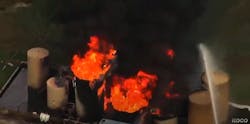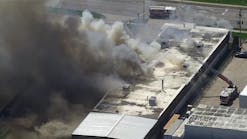There is no mandatory regulation of fixed-facility containers. Recommendations for fixed tank specifications are issued by codes and standards organizations. I have seen a railroad tank car being used as an underground storage tank for a gasoline service station and highway transportation containers being used for fixed storage after they were no longer certified for highway use by the DOT.
Fixed-facility containers can be almost any size and shape. Some of them have names based on their designs and functions, such as the open floating roof tank. Others, however, do not have any specific name or designation, unlike their highway counterparts.
Several National Fire Protection Association (NFPA) standards address the storage of hazardous materials in fixed containers. These include NFPA 30 Flammable & Combustible Liquid Code and NFPA 58 Storage and Handling of Liquefied Petroleum Gases. Both of these codes address the design and safety requirements for specific fixed tanks such as propane and flammable liquid storage. The American Petroleum Institute, the Institute of Petroleum, the American National Standards Institute and others also publish standards - but these are "consensus standards" and do not become law or mandatory until a jurisdiction adopts them. Some jurisdictions have passed local codes and ordinances that regulate certain hazardous materials in fixed containers, but these vary from location to location and do not have the consistence that the DOT regulations provide for transportation of hazardous materials in containers.
Bulk Petroleum Storage
The first tanks to be discussed are those used for bulk petroleum storage. These include tanks with cone roofs, floating roofs, open floating roofs and retrofitted floating roofs. Many of these tanks are associated with tank storage facilities or "farms" where there are multiple tanks at one facility. Tank farms are often connected with pipelines as well as highway, rail and waterway transportation.
Fixed storage tanks have pressures that range from atmospheric (0-5 psi) and low (5-100 psi) to high (100-3,000 psi) and ultra high (above 3,000 psi). Bulk petroleum tanks are generally considered atmospheric pressure tanks.
Cone-roof tanks get their name from the inverted-cone-shaped construction of their roofs. They are atmospheric and low-pressure tanks with cylindrical outer walls supporting the cone roof. American Petroleum Institute Specification 650 calls for the roof-to-shell seam for this tank to be designed to fail as the result of a fire or explosion, reducing the possibility of a pressure buildup.
Cone-roof tanks may be used to store gasoline, fuel oil, diesel fuel and corrosive liquids. Some of these chemicals, such as gasoline, are very volatile and easily produce vapor at normal atmospheric temperatures. Because a cone-roof tank is open inside, the surface of the liquid is exposed to air and product will be lost to vaporization. Therefore, a cone-roof tank is primarily used for non-volatile materials. Contents of cone-roof tanks change frequently: daily, even hourly under some circumstances. These tanks are recognized by the cone-shaped roof and the lack of wind girders or external vents around the top of the sidewall.
An open floating-roof tank has a roof that literally floats on the liquid product in the tank. The outer walls of these tanks are vertical and cylindrical, with the floating roofs eliminating the vapor space in the tank. Drains in place are designed to remove accumulations of moisture on the surface of the tank.
An articulating-arm-type device on the top of the tank functions as a ladder for examination of the interior. As the product level and floating roof go down, so does the end of the arm, which rests on top of the roof. The location of this arm, when viewed from the outside, can be an indicator of the approximate amount of product in the tank. If the arm is completely visible the tank is near full. If the arm is completely inside the tank, it is near empty. A wind girder is located near the top and on the outside of the tank. Primarily a retaining band, the wind girder provides necessary rigidity to the container wall when liquid levels are lowered. An external staircase is also located on the tank wall to provide access to the articulating arm (walkway) on top of the floating roof.
Another version of the floating-roof tank is the covered or internal floating roof. These tanks may resemble cone-roof tanks, but are distinguishable by the vents around the tank near the roof to sidewall seam. The cone roof provides protection from rain and snow, while the internal floating roof eliminates the vapor space above the liquid and helps prevent the loss of vapor into the air.
This style of tank is sometimes used for polar solvent materials, which are miscible with water. If water or snow entered the tank, it would dilute the product. Materials stored in the internal floating roof tank are generally flammable and combustible liquids because of the vapor loss protection of the floating roof on top of the liquid.
A floating-roof tank may also be covered by a geodesic dome that keeps outside weather from affecting the floating roof in the tank. This form of internal floating roof tank also is used for flammable and combustible liquids.
Horizontal Tanks
Horizontal tanks are another kind of tank used for chemical storage in many parts of the country, particularly in rural areas. These tanks range in size from hundreds of gallons to thousands of gallons with low or atmospheric pressure. The ends of the tanks are flat, which usually indicates a limited amount of pressure.
Many horizontal tanks are supported on stands constructed of metal. Unprotected metal can be dangerous during fire conditions, as the metal will be stressed by the heat and fail very quickly.
In the 1950s, six Kansas City, KS, firefighters were killed when the steel supports of a horizontal tank at a gasoline service station failed, sending burning gasoline into their location on the street. NFPA 30, Flammable and Combustible Liquids Code, requires the steel supports of horizontal tanks be protected from flame impingement by encasement in concrete or other non-flammable material. Horizontal tanks may be used to store flammable and combustible liquids, corrosive liquids, and many other types of hazardous materials. A direct result of the Kansas City fire was the requirement for gasoline tanks at service stations frequented by the public to have underground storage tanks.
According to the NFPA, there has never been a fire or explosion involving an underground fuel-storage tank. During the 1970s and '80s, it was discovered that underground storage tanks, which were usually constructed of steel, eventually corrode and leak fuel into the ground. Gasoline and other flammable fuels have a specific gravity less than water, so they will float on water. Moisture that accumulates inside underground storage tanks settles to the bottom of the tank and causes the metal to corrode. Because of the leakage, the U.S. Environmental Protection Agency (EPA) requires that all underground tanks be replaced and safeguards put in place to prevent and detect leaks.
An alternative to the placement of tanks underground was allowed in the form of an aboveground vault. The vault is constructed of concrete and the tank(s) are placed within the vault, partially underground with the vault top above the ground. There is access to the vault from aboveground. Vaults for flammable and combustible liquids must have safety precautions such as monitors installed and must be able to hold the contents of the largest tank if it should leak.
High-Pressure Tanks
Propane and anhydrous ammonia are stored in high-pressure tanks that contain many safety features that are built-in through codes and standards. Industry associations also are heavily involved in safe storage and handling requirements for their members and emergency responders. The National Propane Gas Association (NPGA), in conjunction with the Propane Education & Research Council, has developed a training program for emergency responders with a 220-page text, Facilitator's Guide, CD-ROM and 50-minute video.
Propane tanks range in size from the five-gallon containers used with barbecue grills and 250-gallon tanks used for home heating to bulk-storage tanks containing thousands of gallons of product at propane facilities. Propane tanks generally have rounded ends, which is a primary indicator of a pressure vessel.
Pressure tanks are equipped with relief valves to vent excess pressure caused by increases in ambient temperature. Propane tanks have extensions on the relief valves to extend vapors well above the tank in the event the vapors catch fire. The normal relief valve height is between six and 10 inches. This height allows ignited vapors to lie on the vapor space of the tank, causing it to fail quickly. Anhydrous ammonia tanks do not have the extension, so if you see a horizontal pressure tank with tall relief valves, it is likely to contain propane; if the relief valves are near the tank surface, it is likely to contain anhydrous ammonia.
Anhydrous ammonia, propane and other petroleum gases are liquefied under pressure before being placed in these tanks. The liquid level in the tanks is generally 80% of the tank's capacity to allow for a vapor space. Pressure containers can be dangerous under fire conditions. Relief valves are designed only to relieve normal pressure increases, not those caused by flame impingement from a fire or radiant heat sources.
In the past five years, firefighters in the U.S and Canada have been killed fighting fires involving high-pressure fixed propane containers. Flame impingement on the vapor space of the tank can cause the metal to fail and a boiling liquid expanding vapor explosion (BLEVE) can occur within 20 minutes of the start of the flame impingement. The liquid level of the tank will absorb the heat from flame impingement and not fail as long as the liquid is in the tank. The flame impingement on the liquid level causes the propane in the tank to boil faster and produce more vapors. If the vapor is produced faster than the relief valve can vent it, tank failure can also occur.
Cylindrical tanks are another type of high-pressure tanks, which may be found at refineries or other locations. These tanks look like giant balls suspended in a steel support structure. Tanks of this type can be used for propane and other liquefied petroleum gases, natural gas and hydrogen.
Tube Banks
Tube banks are a type of ultra-high-pressure tank that are often found at compressed-gas companies and distribution facilities. The pressures in this type of tank can be in excess of 3,000 psi. Tube banks are actually a series of individual tanks stacked together with valves and piping into a single outlet/inlet; similar to a fire department cascade system. Unlike the liquefied gases in high-pressure tanks, the materials in tube banks are gases. There is no liquid space to absorb heat. Under fire conditions, these tanks can fail very quickly.
Vertical cryogenic storage tanks are often found next to manufacturing buildings, hospitals, bottled-gas companies and welding-supply houses. A heat exchanger next to the tanks is confirmation that these are indeed cryogenic tanks. Heat exchangers are a series of silver-colored tubes with fins next to the tanks. The heat exchanger allows for the cold liquids to be turned back into gases for use. Ambient air around the tubes and fins of the heat exchanger warms the cold cryogenic liquids into their gas state.
Cryogenic tanks have narrow circumferences and are very tall. These are high-pressure tanks used to store cryogenic liquids, which are very cold. Cryogenics have boiling points of -130 to -452 degrees. Some tanks, particularly those found at cryogenic-production facilities, may each hold as much as 400,000 gallons. Types of materials found in cryogenic containers include natural gas, argon, nitrogen, chlorine and oxygen. They can be flammable, oxidizers or poisons.
Robert Burke, a Firehouse® contributing editor, is the fire marshal for the University of Maryland. He is a certified Hazardous Materials Specialist, and has served on state and county hazmat response teams. Burke is a veteran of over 18 years in the fire service, in career and volunteer fire departments, having attained the ranks of lieutenant and assistant chief, and served as deputy state fire marshal. He has an associate's degree in fire protection technology and a bachelor's degree in fire science, and is pursuing a master's degree in public administration. Burke is an adjunct instructor at the National Fire Academy. He is the author of the books Hazardous Materials Chemistry For Emergency Responders, published in 1997, and Counter-Terrorism For Emergency Responders, published in 1999. Burke can be reached on the Internet at robert.burke@worldnet.att.net. Parts 1 and 2 of this series focused on highway (February) and railroad (April) transportation containers.








